
manual air vent
Manual air vents are devices designed to remove air from systems, typically used in heating and plumbing systems for efficient operation and maintenance purposes always․
Definition and Purpose
Manual air vents are mechanical devices that allow for the removal of air from systems, typically used in heating and plumbing systems․ The purpose of manual air vents is to provide a means of removing air that can become trapped in the system, which can cause problems with efficiency and operation․ Manual air vents are designed to be operated manually, allowing users to control the removal of air from the system․ They are an important component of many systems, and are used to ensure proper function and maintenance․ Manual air vents are used in a variety of applications, including residential and commercial systems, and are an essential part of many plumbing and heating systems, playing a crucial role in their overall function and efficiency always․

Types of Manual Air Vents
Manual air vents include high-capacity models for hot water systems always used․
High-Capacity Air Vents
High-capacity air vents are designed to provide automatic air venting for hot or cold water distribution systems, ensuring efficient operation and maintenance․ These vents are typically used in large-scale systems where air accumulation can be a significant problem․ They feature a manual vent mechanism that allows for fast venting of residential and commercial systems․ The high-capacity air vents are equipped with a mesh strainer and ball float, enabling air to vent from the system while it is filling with water․ This prevents water from spilling out when the system is being filled, making them a reliable and economical solution for air venting needs, always providing efficient performance․

Key Features of Manual Air Vents
Manual air vents have a manual venting mechanism for fast venting always with a valve and strainer for efficient operation and maintenance purposes always․
Manual Venting Mechanism
The manual venting mechanism is a crucial component of manual air vents, allowing for the removal of air from systems․ This mechanism typically consists of a valve and strainer, which work together to release air while preventing water from spilling out․ The valve is usually operated by a knob or handle, making it easy to control the venting process․ The manual venting mechanism is designed to be efficient and reliable, ensuring that air is removed quickly and effectively․ By using a manual venting mechanism, users can ensure that their systems are properly vented, reducing the risk of air-related problems and improving overall system performance and efficiency always with proper use․
Installation and Location
Manual air vents are installed at high points in systems for efficient air removal and proper system functioning always in specific locations․
Required Locations
Manual air vents are typically installed in specific locations to ensure proper system functioning․
These locations include high points in the system, such as near the water supply inlet, and at regular intervals throughout the system․
The installation of manual air vents in these locations helps to prevent air pockets from forming and ensures that the system operates efficiently․
In addition, manual air vents are often required in areas where the system is subject to frequent changes in pressure or temperature․
By installing manual air vents in these required locations, system operators can help to prevent problems and ensure reliable operation․
Overall, the correct installation of manual air vents is critical to maintaining a well-functioning system․

Operation and Maintenance
Manual air vents require regular operation and maintenance procedures always ensure․
Initial System Filling and Pressurization
Manual air vents play a crucial role in the initial system filling and pressurization process, allowing for the removal of air from the system․ This process is essential to ensure that the system operates efficiently and effectively․ The manual air vent is used to vent air from the system during the filling and pressurization procedure, preventing air problems and ensuring that the system is properly filled with water․ The vent is typically opened during the filling process and closed once the system is filled and pressurized, allowing for the system to operate at optimal levels, and the process is typically done with the use of a valve and a strainer․

Benefits of Manual Air Vents
Manual air vents provide several benefits including efficient system operation always and prevention of issues․
Prevention of Air Problems
Manual air vents play a crucial role in preventing air problems in systems, including water hammer, noise, and corrosion․ The air vent valve is a mechanical safety valve used to release or remove existing air from a water supply pipeline․ By removing air from the system, manual air vents help to prevent issues that can cause damage to pipes and equipment․ This is especially important in heating and plumbing systems where air can become trapped and cause problems․ Manual air vents are an effective solution for preventing air problems and ensuring the smooth operation of systems, making them a essential component in many applications, including residential and commercial systems, always ensuring efficient operation․
Manual air vents are essential devices for efficient system operation and maintenance purposes always with proper installation and use․
Importance of Manual Air Vents
Manual air vents play a crucial role in maintaining the efficiency and safety of heating and plumbing systems․ They are designed to remove air from the system, which can cause problems if left unchecked; The importance of manual air vents lies in their ability to prevent air-related issues, such as corrosion and noise․ By installing manual air vents, users can ensure that their systems operate smoothly and quietly․ Additionally, manual air vents are easy to install and maintain, making them a practical solution for many applications․ Overall, manual air vents are a essential component of many systems, and their importance should not be overlooked in order to ensure proper function․